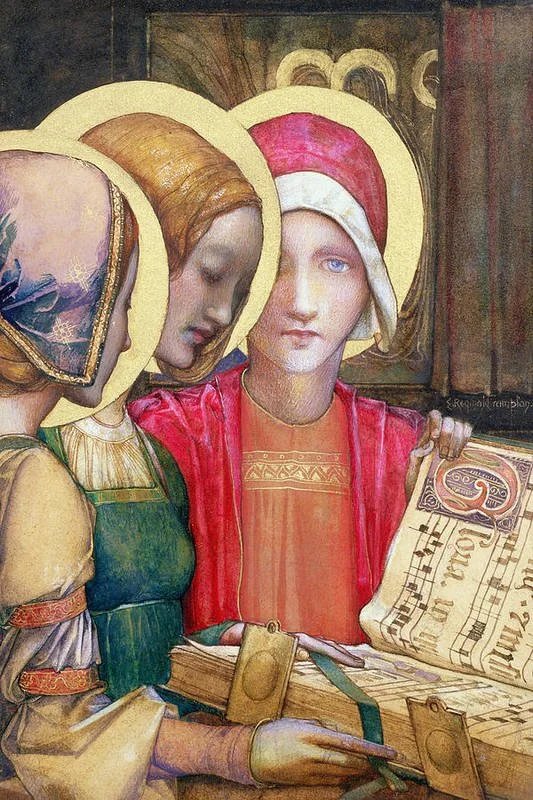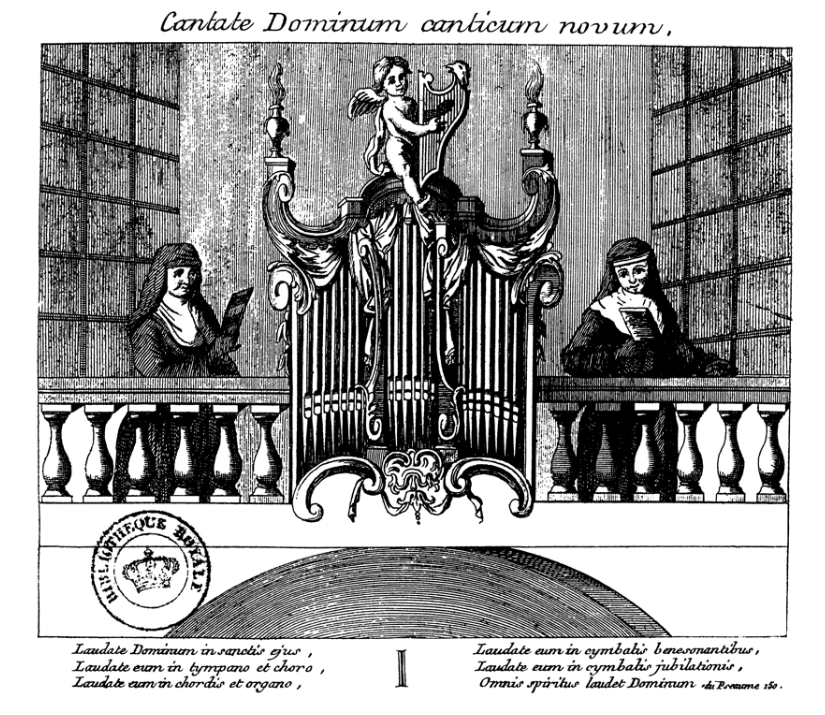A Concert of French Carols
Sunday, December 19, 2021
7:00 PM - 8:30 PM PST
Ascension Episcopal Parish (map)
A concert of French carols for Advent and Christmas. The program includes Michel Corrette’s charming Baroque mass for sopranos and organ on traditional French carol melodies. This free concert will be livestreamed from Ascension Episcopal Parish on this page, as well as on Facebook.
Due to COVID social distancing guidelines, a limited number of seats are available for a live audience at this concert. To attend in-person, please RSVP to music@ascensionepiscopalparish.org!
Charlotte Engler, soprano
Emma Mildred Riggle, soprano
Hannah Brewer, organ
Program
GABRIEL FAURÉ (1845-1924)
Il est né, le divin enfant
Noël des enfants
TRADITIONAL FRENCH CAROLS newly arranged for two sopranos a cappella
JEAN-JACQUES BEAUVARLEt-CHARPENTIER (1734-1794)
Noël Grand Chœur: “Laissez paître vos bêtes”
Noël en Récit de Flûte: “Ah! ma voisine êtes-vous fâchée?”
MICHEL CORRETTE (1707-1795)
Messe pour le tems de Noël (1788)
Program Notes
Michel Corrette: Cheering the Melancholy
Traditional carols, or noëls, held a special place in the repertoire of French Baroque organists. These noëls generally originated not as liturgical music, but as folk songs, popular songs, or even dances. Despite the tunes’ playful origins, at Christmas, the Catholic church in France allowed organists to work these noëls into their church music, and as a result, we have the fascinating mix of popular and sacred which is the Baroque noël d’orgue.
Organist-composers like Jean-François Dandrieu (c. 1682-1738), Louis-Claude Daquin (1694-1772) and Jean-Jacques Beauvarlet-Charpentier (1734-1794) all arranged popular noëls for organ, sometimes as short voluntaries, sometimes as sets of variations. These charming works remain part of the parish organist’s repertory today, popping up every Christmas at churches of all denominations.
And organ noëls were just the beginning: these versatile tunes also formed the basis for sinfonias and even masses. Famously, the Messe de minuit pour Noël (Midnight Mass for Christmas Eve), a mass for chorus and orchestra by Marc-Antoine Charpentier (1643-1704), is based entirely on noëls. Imagine the fun of coming to church on Christmas Eve and hearing the familiar words of the Mass sung beautifully to the tune of that favorite carol you like to sing at parties - that’s the experience French composers of the 17th and 18th centuries offered when they based compositions on noëls.
Portrait of Michel Corrette from his 1738 violin method book, L'Ecole d'Orphée (The School of Orpheus)
No composer’s noëls are more sheer fun than those of Michel Corrette (1707-1795). You’ve likely not heard of this rather obscure composer unless, like me, you’ve looked for Christmas music suited to a small tracker organ, and found Corrette’s four delightful suites of noëls d’orgue.
Music was in Corrette’s blood: both his father and his son were also organists. Corrette served for fifty-three years as organist of Sainte Marie du Temple in Paris. In addition to performing, and composing music for the church, the theater, and the home, Corrette was a dedicated teacher: he authored method books on instruments ranging from the harpsichord to the mandolin to the bassoon. His thorough descriptions of musical technique offer a wealth of information for musicologists studying 18th-century French performance practice.
Corrette’s life spanned the eighteenth century, a time of massive musical and cultural change. He was born into the Baroque, and he cultivated that style throughout his life, even after it fell out of fashion in favor of the midcentury galant style, and the advent of the Enlightenment composers like Haydn and Mozart. His life was wrapped up in church music, right until an abrupt shift in 1791, when the French Revolution’s Dechristianization of France closed his church.
Title page of Corrette’s Quatre messes à deux voix égales (Paris, 1788)
In fact, when Michel Corrette published his carol mass as part of his Quatre messe à deux voix égales avec l’accompagnement de l’Orgue à la usage des Dames Religieuses (Four Masses for Two Equal Voices and Organ, for the use of Nuns) in 1788, his timing could hardly have been less propitious. The storming of the Bastille would take place just a year later. Not only was Corrette’s Baroque-sounding Messe pour le tems de Noël decidedly old-fashioned; convents, the Mass, and all expression of Catholic worship would soon face violent suppression.
All of this offers clues about why Corrette’s charming mass on carol melodies is so much more obscure than Charpentier’s, which had been written in the comparative tranquility of the year 1690. Despite its gracious vocal writing and plethora of fun carol tunes, Corrette’s Messe pour le tems de Noël was more or less doomed to obscurity by its cultural context.
There are plenty of reasons to give Corrette’s carol mass another chance. Its versatile scoring was a brilliant marketing move both for his own time (apart from that inconvenient Revolution) and for our own. Scored for two voices and organ, the mass can be sung by a choir of nearly any combination, whether it be all women, all men, a mixed choir divided in two parts, or even just a couple soloists, as we’ll be performing it at our concert. The composition’s organ part is flexible enough to work on a grand instrument of several manuals, or on a tiny one like the organ at Ascension, and as most of it is written in figured bass, it gives the organist the freedom to ornament and improvise as much or as little as desired. With simple ensemble parts and solo movements with graciously idiomatic vocal writing, Corrette’s mass has got a bit of something for everyone in a church (or convent) music program. It was well within the reach of even small convents, or in our case, that of a church limited to a small ensemble in the age of COVID-19.
Illustration from the first edition of Corrette’s Quatre messes à deux voix égales.
In addition to its practical versatility, I love Corrette’s Messe pour le tems de Noël because of a quality that we sometimes don’t associate with eighteenth-century music: fun. Between the interest of seeing which carol tune comes next, the playful interaction of the two voice parts, and the frankly cute organ interludes, this mass is simply a delight to sing. There are plenty of profoundly moving mass settings out there, but joy is an important part of the Christian life too, and joy is simply bursting through this music.
Michel Corrette may not have been interested in keeping up with the latest galant styles in music, but we know one musical idea that did interest him: sharing happiness. Between ca. 1732-1773, Michel Corrette composed a total of 25 works which he called concertos comiques (Comic Concertos). These concertos were intended to be played as divertissements between the acts of comic operas, and each is based on a popular French tune - not unlike the carol melodies Corrette’s used his Messe pour le tems de Noël. The published edition of his first Concerto comique (c. 1733) bears this inscription:
Cover of Corrette’s first Concerto comique, “Le Mirliton” (The Hussar’s Hat) Op. 8 No. 1 (c. 1733)
Ouvrage utile aux Melancholiques.
[A useful book for those who are melancholy]
There are many in 2021 who find themselves facing melancholy for a host of cultural reasons - not to mention those who face seasonal depression every year, the stress of the commercialized holiday season, the complexity of memories called up by celebrations, and the reflection attending the close of another year. Corrette’s Messe pour le tems de Noël offers a bit of playful cheer that I find of great use for those who are melancholy - wrapped up in the timeless prayers of the Mass and its plea of dona nobis pacem: grant us peace. We hope that our little concert shares both cheer and peace with you.
Noëls for 2021
From a practical standpoint, I programmed Corrette’s Messe pour le tems de Noël at this concert because it is a perfect fit for the limited performing forces I have available after months of COVID-19. Our merry band consists of two sopranos and one organist who love early music, we have a small Baroque-style tracker organ, and we’re singing in Ascension’s tiny chapel.
Though we are equipped to reproduce the sound of Corrette’s mass pretty authentically for you, we do face one major challenge: unless you live in 18th-century Paris, dear audience, you are not likely to recognize most of the tunes Corrette quotes in his music. For Corrette’s original audience, the familiar tunes were integral to the music’s charm, so in order to maximize your enjoyment of this music, we have to acquaint you with some of these lovely traditional French noëls.
Our concert includes nine of the traditional noëls Corrette quotes in his mass, newly arranged for two sopranos. It took some musicological detective work for me to find them. Unlike Charpentier in his Midnight Mass, Corrette did not helpfully label each movement with the name of the carol he quotes within. Instead, I had to comb though the work and check my books of organ noëls for matching melodies in order to find the carols’ titles. May I add that Corrette more than one-ups Charpentier when it comes to carol sampling: Charpentier’s 25-minute Midnight Mass quotes eleven noëls, but in Corrette’s shorter mass, I counted no fewer than eighteen unique carols!
After identifying the melodies, I needed to connect them with their original texts. I consulted a variety of sources on French traditional carols, like the 1803 edition of La grande Bible de Noëls Angevins, sur la Nativité de Notre Seigneur Jesus-Christ, which was published in Paris just a few years after Corrette’s death. After identifying the tunes and texts, I selected nine of the noëls and I made a very late jump onto the Baroque French noël arrangement bandwagon - that is, I composed my own arrangements of the tunes. In our concert, you’ll hear them scored for two sopranos a cappella. My style makes occasional nods to Corrette’s, but my main goal was to create settings that were custom-made for Charlotte’s unique voice and mine.
- Emma Riggle
Minister of Music, Ascension Parish
Cover image:
A Carol by Edward Reginald Frampton (1827-1923)






